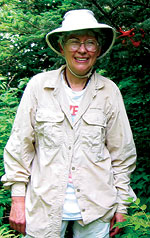Awhile back, I started recording the trails I’ve hiked in the Smokies using a spreadsheet. First I created a comprehensive list using the book Hiking Trails of the Smokies, affectionately known as the “Brown Book.” Each time I hike a section of trail, I enter the mileage and date.

There are 781.1 miles of trails in the park, and at this point I have less than 200 miles to go. Yet I’m not close to reaching my goal, because the remaining trails lie in the center of the park. So in order to log “new” Smokies miles, I have to plan multi-day backpacking trips using sections of trail that I’ve already covered.
Numbers can be deceptive. According to the Web site of the Great Smoky Mountains 900-Miler Club, which oversees this particular hiking challenge, it can take as many as 1,500 miles of walking to complete all the Smokies trails. It also takes a lot of driving. I missed a section called the Cane Creek Trail on the western side of the park, west of Cades Cove. To reach it, I’ll have to drive almost three hours one-way and hike 6.2 miles into the park to add a paltry 2.1 new miles to my list.
Mind you, not all hiking goals are so complex logistically. Most involve either climbing all the peaks in a given area or walking a long-distance trail, such as the AT, end to end. One such challenge, the South Beyond 6,000 or “SB6K,” consists of the 40 mountains higher than 6,000 feet in the South. They range from Mount Mitchell, the highest at 6,684 feet, to Mount Sequoyah in the Smokies (6,003 feet). Some peaks—Mount Le Conte and Cold Mountain, for example—are famous. Others, such as Marks Knob and Tri-Corner Knob, are forested bumps that no one ever hears about unless they’re doing the SB6K. Scaling these peaks encourages hikers to explore the region in a methodical manner and move beyond the busiest areas. Without such a list, we’d all be concentrated in the same few destinations.
Hiking challenges like these originated with the Munros, the 284 peaks in Scotland higher than 3,000 feet, and have since taken hold around the world. Peak-bagging in the United States can be traced back to Bob Marshall, who in 1921 become one of the first people to climb all 46 “high peaks” in New York state’s Adirondacks. Mostly in the 4,000-foot range, the Adirondacks are modest by Southern standards, but they’re so rocky that they wind up being more challenging to climb than the SB6K.

Challenge fever struck me soon after I began hiking in my early 20s. My first challenge was the New Hampshire 4,000-footers, the 48 mountains in that state higher than 4,000 feet. From there, I moved on to the New England 4,000-footers, another 15 peaks in Vermont and Maine. They consumed my next few years’ worth of vacation days and racked up more AT miles. When I finished the New England peaks, I’d walked 135 miles of the Appalachian Trail.
Closer to my New Jersey home, in New York’s Catskills, I climbed the 34 peaks above 3,500 feet during the warm months—and all over again in winter. It earned me two more patches but no additional AT miles.
After that, all the mountain challenges stopped while I concentrated on the AT. For several years, my husband and I spent our vacations backpacking and filling in pieces of the trail till we finished it in 1998, after 24 years. In the wake of that achievement, I felt a letdown for a while, until we started on the Adirondack 4,000-footers—another 48 mountains in New York state, and remoter still than the New Hampshire set.
Hiking isn’t meant to be a competitive sport; there’s no need to walk faster or longer than someone else. But each new challenge seems to grab me the same way. First, I’m just hiking. I may start a file to keep track of the miles, but there’s no commitment yet. Then I look over my records and realize I’m within striking range of a particular milestone. Over the years, I’ve even finished the nine “great walks” in New Zealand—eight multi-day walks and one canoe trip—that the New Zealand Department of Conservation has named as the highlight of the country. No one was offering a patch for that. But when I moved to Asheville, I found I was able to walk away from completing the Adirondacks 4,000-footers without looking back—so maybe I’m not addicted after all.
Detractors
Not all serious hikers are into challenges. These detractors announce that they’re not peak-baggers, likening the obsession to collecting Girl Scout badges. Marianne Newman, who helps others with the logistics of finishing their Smokies 900 and SB6K challenges, is proud not to keep records of her hikes.
“I am not into all this hike bookkeeping. It’s too much like work,” she says. Some make a point of not finishing the AT so they can keep going back to it. If they leave the trail before climbing Mount Katahdin in Maine, well, they haven’t finished the AT, and they’ll just have to start all over again.
In case you’re wondering
This is not a race, and there’s no time limit. You have a lifetime to meet any challenge, including the AT. Besides, these things work on the honor system—no one checks whether you’ve really done it all. To apply for a patch, you must list the date you did each peak or trail and who, if anyone, you did them with. As you learned in school, if you cheat, you’re only cheating yourself.
One of the peculiarities of the SB6K is that you can actually drive to the summits of some of them. The tower on Clingmans Dome is only a half-mile from the parking lot, and the top of Mount Mitchell lies even closer to asphalt. The solution is a list of approved routes, which ensures that the hiker walks at least five miles round trip and ascends at least 500 feet. In reality, most mountains require a lot more effort. Check the Carolina Mountain Club Web site (www.carolinamtnclub.org) for application forms and details.
I’ll finish the Smokies 900 in a couple of years, and then what? There’s the Pisgah 400 (all the trails in the Pisgah District), but I’m not really serious about that—I’m just hiking them.
[Hike leader and outdoors writer Danny Bernstein wrote Hiking the Carolina Mountains, which comes out in April. She can be reached at danny@hikertohiker.org.]



Before you comment
The comments section is here to provide a platform for civil dialogue on the issues we face together as a local community. Xpress is committed to offering this platform for all voices, but when the tone of the discussion gets nasty or strays off topic, we believe many people choose not to participate. Xpress editors are determined to moderate comments to ensure a constructive interchange is maintained. All comments judged not to be in keeping with the spirit of civil discourse will be removed and repeat violators will be banned. See here for our terms of service. Thank you for being part of this effort to promote respectful discussion.